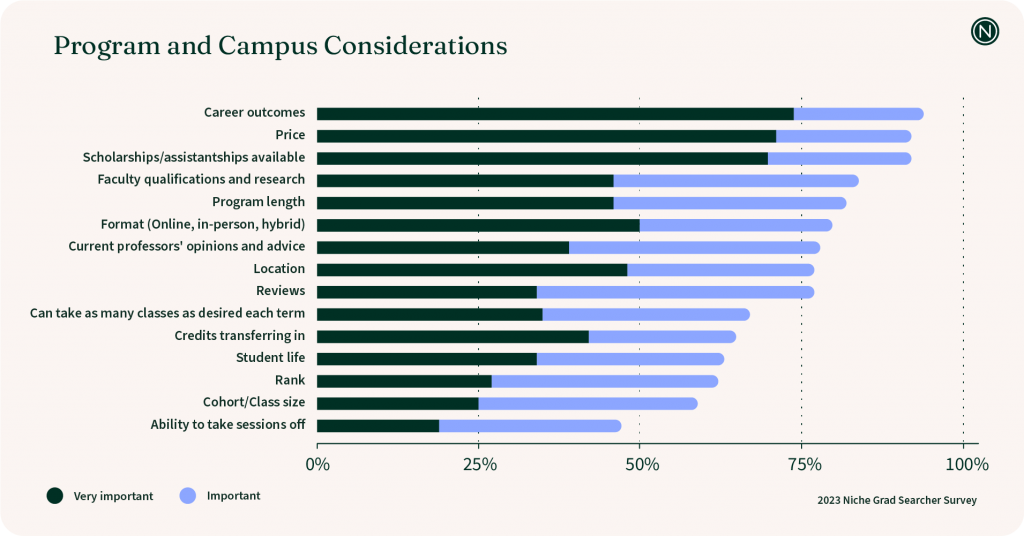Overview
The demand for postgraduate programs is increasing globally, particularly among international students, influenced by career prospects and financial factors.
Higher education institutions need to use competitive intelligence to create targeted recruitment strategies that highlight their unique attributes and meet student needs.
Introduction
The global landscape of higher education is witnessing a surge in postgraduate enrolments and a shift in how to recruit graduate students.
A recent study revealed postgraduate programs are more popular among international students than they’ve ever been before.
This trend aligns with data from the Higher Education Statistics Agency (HESA) in the UK, where postgraduate programme applications have also seen a steady rise.
Navigating the complexities of recruiting international and postgraduate students requires a comprehensive understanding of global trends, government policies, and the competitive landscape.
You also need to be aware of the unique needs and aspirations of this specific demographic, so you can tailor your recruitment efforts accordingly.
This guide will equip you with a step-by-step approach to refine your institution’s postgraduate student recruitment strategy.
We’ll also demonstrate how the insights gained from competitive intelligence can help position your university or college as the preferred choice for prospective candidates.

Understanding Your Target Audience
Before we look at how to recruit graduate students with a clear strategy, it’s crucial to understand this demographic group more clearly.
Postgraduate students are a multifaceted group, each with unique goals and drivers. They have diverse backgrounds, academic interests, and career goals.
Their decision to pursue further education is driven by a range of factors, from the reputation of the institution, to the potential for career advancement.
To engage them effectively you must tap into their specific characteristics and motivations. Market research and competitive intelligence provides a wealth of insights into these factors.
The importance of career prospects
For example, a study by The Student Room indicates that a significant majority of students, about 71%, choose their postgraduate courses with future careers in mind. This highlights the importance of career prospects in their decision-making process.
Additionally, the study also suggests that financial considerations play a crucial role, with funding being a major barrier for many prospective students.
By leveraging these insights, you could fine-tune international and postgraduate recruitment strategies to emphasise the two key factors related to career outcomes and financial support. This targeted approach of aligning offerings with the aspirations and needs of international and postgraduate students, ensures recruitment efforts will hit the mark and remain effective.
Tailoring Your Marketing Messages & Channels
In the competitive sphere of student recruitment, the art of persuasion is subtle yet powerful.
Your marketing messages are the voice of your institution, and how you articulate them can make the difference between blending in and standing out.
By meticulously crafting your messages and strategically selecting your distribution channels, you can ensure that your marketing efforts not only reach the right eyes and ears — but also the hearts and minds of your target audience.
1) Crafting a unique narrative
Identify the core of what makes your institution unique and articulate it clearly. Your narrative should weave the aspirations of postgraduate students with the strengths of your institution.
Your message should mirror the ambitions of your students, showing them how their academic and professional aspirations align with your offerings.
2) Choosing the right marketing channels
In today’s digital age, a strong presence across social media and other online platforms is crucial.
But it’s not just about being there; it’s about being impactful. In order to be effective, you need to tailor your content to fit the nuances of each platform. For example:
– LinkedIn to highlight alumni success and professional opportunities
– Instagram for campus life and student activities
– Twitter for quick updates and news
– Facebook groups for community development
3) Engaging through personalisation
In a world inundated with generic advertising, personalisation stands out. A personalised email or message can make a prospective student feel seen and valued.
Use data analytics to understand the interests and behaviours of your target audience, then tailor your messages to address their specific concerns and aspirations.
4) Leveraging alumni & partnerships
Alumni are your brand ambassadors. Their stories of success are a testament to the value of your programs. Engage them in your marketing efforts, be it through guest lectures, webinars, or testimonial videos.
Similarly, partnerships with international educational agencies can extend your reach to corners of the world you might not have direct access to. These agencies can provide a local perspective and help tailor your message to resonate with different cultural contexts.
5) In-person interactions
Don’t forget the power of in-person meetings and real-life interactions. Recruitment fairs and campus visits allow prospective students to experience the unique essence of your institution first-hand.
These interactions are invaluable in building a personal connection with prospective students that digital means simply cannot replicate.
Enhancing Student Experience & Support
Creating a nurturing environment for international and postgraduate students is vital for their success and well-being. It’s about ensuring that from the moment they consider your institution, they feel supported and valued.
This holistic approach to student support not only enhances their experience, it also contributes to higher student satisfaction and retention rates.
A) Pre-arrival support
The journey begins even before students set foot on campus. Pre-arrival support is your first opportunity to make a lasting impression.
Provide comprehensive guides on visa processes, accommodation options, and cultural adaptation. Consider a welcome package that includes a checklist of tasks to complete upon arrival and a schedule of orientation events.
B) Orientation programmes
Orientation is more than just a campus tour; it’s an introduction to a new chapter in life. Craft orientation programmes that are informative and engaging.
Include sessions on academic expectations, research opportunities, and networking events with faculty and peers. Make sure to address the specific needs of international students, such as language support and cultural integration.
C) Ongoing academic & pastoral care
Support should not end after the first week. Ongoing academic guidance through advisors and mentors can help students navigate their courses and research projects.
Pastoral care, including counselling services and peer support groups, ensures that students’ mental and emotional needs are met.
How To Recruit Graudate Students: Using Competitive Intelligence
When it comes to the competitive landscape of student recruitment, competitive intelligence is your ace in the hole. It involves the process of gathering and analysing actionable information about competitors, market trends, and student preferences.
This intelligence becomes the foundation upon which you can build a robust recruitment strategy that not only meets, but also anticipates the needs of your target demographic.
Integrating CI into your graduate student recruitment strategy
To effectively integrate CI into your recruitment strategy, consider the following:
Market analysis: Use CI to analyse global education trends and student mobility patterns. This will help you understand where demand for postgraduate education is growing and what factors influence students’ choices.
Competitor benchmarking: CI provides a clear picture of your competitors’ strengths and weaknesses. Use this knowledge to differentiate your institution and highlight unique opportunities that you offer.
Student insights: CI helps you gather data on student preferences, concerns, and decision-making criteria. This helps you tailor messaging and support services to meet these specific needs.
Adaptive strategies: The insights gained from CI can be used to continually adapt and refine your recruitment strategies. This ensures that your institution remains responsive and relevant to the evolving market.
Collaboration & Partnerships
When assessing how to recruit graduate students and relevant strategies, it often hinges on strong partnerships.
Collaborating with government agencies, industry leaders, and alumni networks can significantly enhance your institution’s reach and appeal for prospective postgraduates.
Government agencies: Tap into scholarships, streamline visa processes, and access policy support to make your programs more accessible.
Industry partners: Create internships and practical experiences that align academic learning with industry needs, showcasing real-world application and career pathways.
Alumni networks: Utilise the success stories of former students to inspire and attract new ones, demonstrating the tangible outcomes of your educational offerings.
6 Recommendations For Admission Officers & Marketers
1) Develop compelling messaging: Craft clear, concise messaging that resonates with your target audience’s aspirations and career goals.
2) Leverage digital marketing: Utilise a variety of digital platforms, social media, and content marketing strategies to reach international students effectively.
3) Invest in quality content: Create informative and engaging content, including program details, virtual tours, and testimonials from international alumni.
4) Highlight financial aid opportunities: Showcase scholarships, fellowships, and financial aid options to attract a wider pool of talent.
5)Build strategic partnerships: Collaborate with international student recruitment agencies, educational institutions abroad, and industry leaders.
6) Embrace competitive intelligence: Gather insights into competitor strategies to stay ahead of market trends and competitor moves in the international postgraduate market.
How To Recruit Graduate Students – The Key Takeaways
By implementing the recommendations in this guide and adopting a holistic approach to student recruitment, you can position your institution for success with a strategic and data-driven approach.
- The global demand for postgraduate programs, particularly among international students, is at an all-time high.
- Higher Education Institutions must monitor the competitive landscape and differentiate themselves by highlighting their unique strengths and value propositions.
- Understanding the motivations, preferences, and challenges of international postgraduate students is crucial for crafting targeted recruitment strategies.
- Utilising competitive intelligence and market research allows for data-driven decision making and impactful program promotion.


